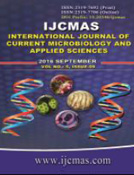


 National Academy of Agricultural Sciences (NAAS)
National Academy of Agricultural Sciences (NAAS)

|
PRINT ISSN : 2319-7692
Online ISSN : 2319-7706 Issues : 12 per year Publisher : Excellent Publishers Email : editorijcmas@gmail.com / submit@ijcmas.com Editor-in-chief: Dr.M.Prakash Index Copernicus ICV 2018: 95.39 NAAS RATING 2020: 5.38 |
Salvinia Guettard is a Weed of National Significance and is regarded as one of the worst weeds because of its invasiveness, potential for spread, and economic and environmental impacts. It is an aquatic weed that can choke waterways. It floats on still or slow-moving water and can grow rapidly to cover the entire water surface with a thick mat of vegetation. This shades out any submerged plant life and impedes oxygen exchange, making the water unsuitable for fish and other animals. Heavy metal toxicity and the danger of their bioaccumulation in the food chain represent one of the major environmental and health problems of our modern society. A very promising, environmental-friendly and cost effective alternative is plant based bioremediation or phytoremediation. Aquatic ferns in particular exhibit exorbitant potential to remove various contaminants including heavy metals, organic compounds, radionuclides from the environment. Among various aquatic macrophytes Salvinia, a free-floating aquatic fern holds a distinct position because of high productivity and tolerance to a wide range of temperatures. In the present investigation bioremediation of heavy metal contaminants by three species of Salvinia, viz. S. natans, S. molesta and S. auriculata was studied. It was found that various concentrations of heavy metals caused considerable reduction in the fresh weight and increase in dry weight of all the three species. All the three species of Salvinia showed a decline in fresh weight with increasing concentration of Cd, Cu, Cr, Hg, Pb, Ni and Zn. After 10 days of treatment the all the three species of Salvinia showed a substantial amount of accumulation of heavy metals in their tissues. The bioaccumulation of heavy metals increased with increasing the concentration of heavy metals. Salvinia molesta showed maximum accumulation of Hg, Ni and Pb in the concentration of 18575ppm, 18875ppm and 18275ppm respectively. It can be concluded that Salvinia natans, S. molesta and S. auriculata are efficient in accumulating highest amounts of heavy metals. The results obtained in the experimental study proves the fact that Salvinia natans, S. molesta and S. auriculata have the innate capacity for the accumulation of appreciable quantities of heavy metals.
 |
 |
 |
 |
 |